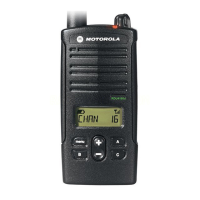Theory of Operation 3-7
although the ground return path in the base station/repeater is also achieved through the station
chassis.
In addition to the signal and power connectors, a 4-pin header (J6002) and 2-pin jumper is located in
this same area. This is not supported, and has no impact on HW functionality regardless of jumper
position.
3.2.4.1 SPI
The SPI circuitry within the PA includes the analog to digital converter (A/D), digital to analog
converter (D/A), non-volatile memory (NVM), and the customer programmable logic device (CPLD).
A brief description of the PA SPI devices is shown below.
• CPLD – Main PA SPI interface, with all other PA SPI devices connected through this device.
This device performs addressing to the other SPI devices using the two address lines from
the SCM. One single bit output on the CPLD controls the PA fan for diagnostic purposes, and
another single bit output is used for the PA identification meters
• NVM – EEPROM that is used to store PA calibration data and identification information
• D/A – Converts SW digital signals to analog within the PA. This controls the PA power control
circuit
• A/D – Converts analog signals within the PA to digital for SW interface. These signals are
used by SW for HW metering.
3.2.4.2 Power Control
A combination of SW and HW controls are used to regulate the PA transmit power level. The PA
output power is regulated by the power control loop within the PA. This control loop uses a reference
voltage from a digital-to-analog (D/A) converter that is programmed by SW through the SPI bus. The
D/A programmed value is determined based on the calibration information stored in the PA NVM.
Once programmed, the PA power control loop will level the output power to the requested level, if
possible.
The temperature sense circuit within the PA can also affect the power control loop, and if an
excessive thermal condition exists, the control loop will be forced to reduce output power in order to
protect the PA HW from damage. The more excessive the thermal condition, the greater the amount
of output power reduction.
3.2.4.3 Metering
The DC Distribution Board contains the PA metering circuitry used by both SW and internal PA HW
for determining when fault conditions are present and take appropriate action when needed.
Metering is performed in order to support the PA related alarms including high temperature, VSWR,
low/high main supply voltage, low output power, and fan failure. The metering signals are tied to the
A/D, and are monitored by SW as required in order to determine when fault conditions exist.
3.2.4.4 Fan Supply
The PA fan is powered through the Distribution Board. The supply to the fan is connected through a
feed-through capacitor on the fin side of the PA cast heat sink. The fan ground connection is
attached to the PA cast heat sink. The fan supply is controlled by either SW or HW. When a thermal
limit defined by the PA HW has been exceeded, the HW control circuit will enable the fan supply

